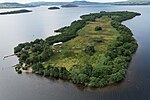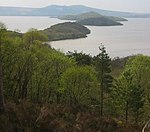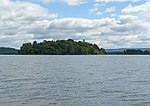Ellanderroch
Islands of Loch LomondScotland geography stubsUninhabited islands of Stirling (council area)

Ellanderroch (Scottish Gaelic: Eilean Darach/Eilean nan Darach meaning "oak island") is an island in Loch Lomond in Scotland. It is a very small island, 100 metres in breadth at its widest point. It lies a short distance to the south-west of the larger island of Inchfad. The island has been used as a shelter for fishermen. There are many oaks left on the small island; a hollow one was filled in with concrete, but was struck by lightning, and now only the concrete remains.
Excerpt from the Wikipedia article Ellanderroch (License: CC BY-SA 3.0, Authors, Images).Ellanderroch
Low Path,
Geographical coordinates (GPS) Address Nearby Places Show on map
Geographical coordinates (GPS)
| Latitude | Longitude |
|---|---|
| N 56.079444444444 ° | E -4.5811111111111 ° |
Address
Low Path
G63 0JS
Scotland, United Kingdom
Open on Google Maps










